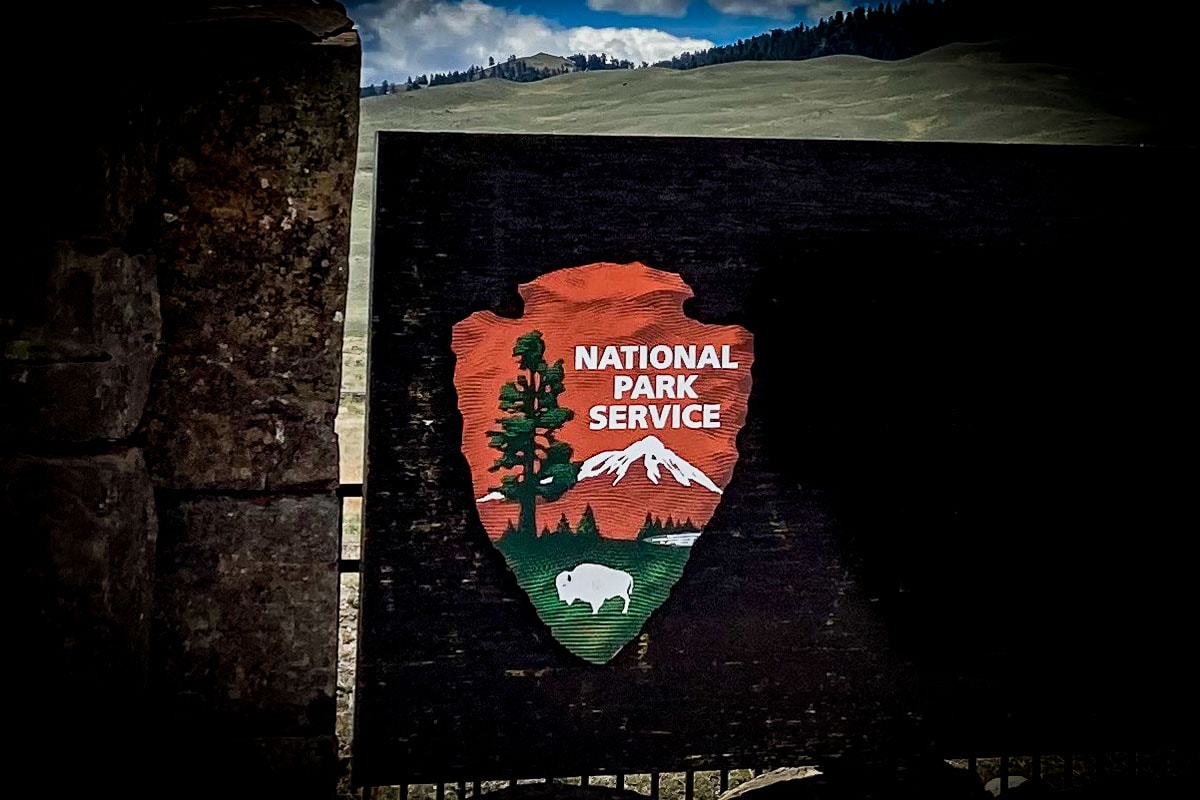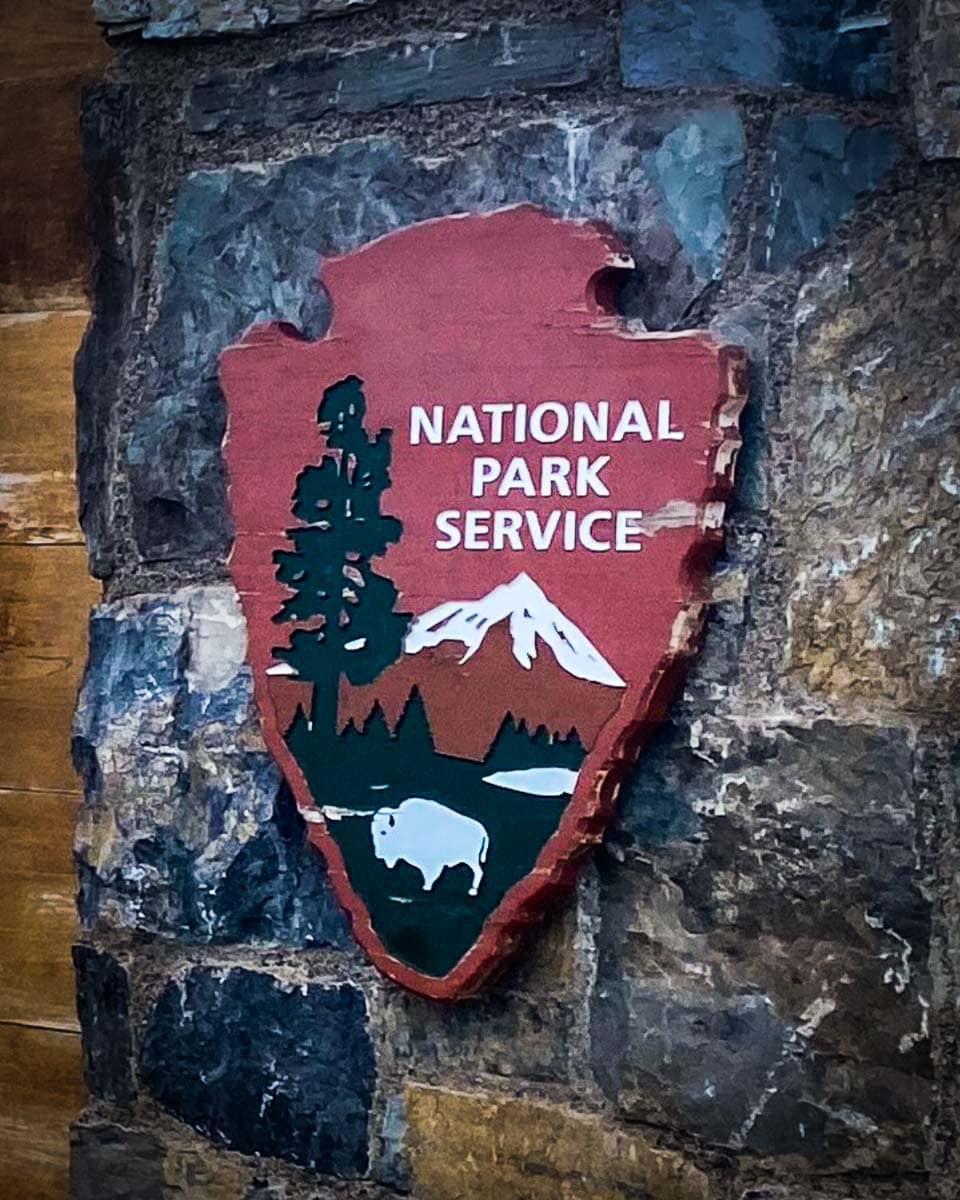Among American nature lovers, outdoor enthusiasts and wildlife watchers, few symbols are as well-known as the National Park Service Arrowhead logo.
This iconic logo is the visual identity of the National Park Service (NPS).
A federal government agency under the Department of the Interior, the NPS manages all U.S. national parks, along with hundreds of other sites, from national monuments and memorials to battlefields and historic sites.
As familiar as the National Park Service Arrowhead logo may be, not everyone is aware of the meaning of its many elements, from the depicted natural features to the logo’s very shape. Arguably even fewer people know about the history of the NPS Arrowhead.
So, if you’re interested in learning more about the iconic National Park Service logo, you’ll find some fascinating facts below!

History of the National Park Service Arrowhead Logo
Did you know that the now-ubiquitous NPS Arrowhead didn’t even exist before 1951?
In the first 35 years after the NPS was established, the Park Service used another emblem, which was never formally recognized.
During those first decades, there was “agitation within the Park Service for some emblem that would identify the Service as the shield did the Forest Service,” the Badges and Ornamentation of the National Park Service website says.
It wasn’t until 1949 that the Park Service’s logo design was first taken seriously. A service-wide contest was held to create a new emblem that properly symbolized what the National Park Service stood for.
Although the contest-winning logo, designed by landscape architect Dudley Bayliss, was never actually put into service, it did mark a milestone in the National Park Service’s search for its own identity.
The winning design sparked a debate about what the ideal NPS logo should look like, which ultimately led to the creation of the iconic Arrowhead logo in 1951.
Historian Aubrey Neasham planted the first seed for the logo’s eventual design in a discussion with Director Newton B. Drury, suggesting that the emblem should represent the Park Service’s primary function “…like an arrowhead, or a tree, or a buffalo.”
This idea was developed further by Herbert Maier, the architect who was responsible for making “parkitecture” or “National Park Service rustic” the characteristic architectural style for the national parks.
It was he and his staff who created the NPS Arrowhead, based on Neasham’s suggestion.
The new logo was first used in a brochure for Oregon Caves National Monument and as a plaque at the NPS conference in 1952. The Arrowhead adorned National Park Service uniforms for the first time in 1955.
NPS Arrowhead Timeline
The First Decades
- 1916: The National Park Service is established and the first logo appeared. It featured a circle containing a cone of a sequoia tree flanked by two branches. Despit being used (here and there) until the mid-20th century, this original NPS logo was never formally recognized.
- 1949: A NPS logo design contest is held. Landscape architect Dudley Bayliss won the contest and its $50 prize, using the letters N.P.S. to create a mountain range with a road leading towards it. However, this design was never put into service.
- 1949: Historian Aubrey Neasham discussed the winning logo with Park Service Director Newton B. Drury and suggested that the Park Service needed a logo that expressed its primary function “…like an arrowhead, a tree, or a buffalo.” He sketched out a design featuring a long arrowhead with a pine tree.
Arrowhead Logo Design and Implementation
- 1951: Neasham’s logo concept appealed to the new Park Service Director, Conrad Wirth. He passed it on to Herbert Maier, the architect who made “parkitecture” the architectural identity of the National Park Service. Now assistant director of the Pacific West Region, Maier and his staff developed the concept, ultimately creating the famous NPS Arrowhead logo featuring a sequoia tree, bison, mountains and water.
- 1951: Secretary of the Interior Oscar L. Chapman formally authorized the new National Park Service logo on July 20, 1951.
- 1952: The Arrowhead logo was put into service for the first time. It featured in the Oregon Caves National Monument brochure that year, while also appearing as a plaque at a NPS conference.
- 1955: The Arrowhead logo adorned National Park Service uniforms for the very first time. Quickly gaining recognition as the Park Service’s official symbol, it began appearing in publications and on signs throughout the National Park System.

Official Designation and Registration
- 1962: Ten years after its first use, the NPS Arrowhead was designated as the official National Park Service symbol by publication in the Federal Register of March 15, 1962. This was to prevent unwanted commercial use of the increasingly popular Arrowhead design.
- 1965: The Arrowhead logo was registered with the U.S. Patent Office on February 9, 1965. Later on, the Trademark Act would offer it additional protection (which it still does).
A Failed Attempt to Switch Logos
- 1966-1969: Part of a plan to modernize the National Park Service, new logo designs were introduced for both the National Park Service and the Department of the Interior. A new, rather abstract design was about to be implemented, but met with backlash and rejection from Park Service employees who disliked the “triangles and cannonballs” design.
- 1970: The Park Service went back to the original Arrowhead logo in 1970. It has been in use ever since and continues to “enjoy strong acceptance among Service employees.”
Adapting to the Internet Age
- 2001: Along with the implementation of the Unigrid brochure design, the Communicating the National Park Service Mission, also called the Message Project, dramatically improved the visual identity of the National Park Service. Numerous new tools enhanced the Park Service’s communications strategy, including graphic design and sign technology.
- 2014-present: A number of small changes were made to details of the NPS logo. This includes minor modifications to the tree, bison and mountains. Additionally, a shaded relief version of the NPS Arrowhead logo was designed for use in publications.

Meaning of the National Park Service Arrowhead Logo
The National Park Service never officially explained or outlined the meaning of the various elements on the NPS Arrowhead logo. However, those elements do represent, quite clearly, the many aspects of America’s National Park System.
The logo’s bison symbolizes all wildlife that lives in the national parks, while the sequoia tree and grassland represent all vegetation.
The mountains stand for scenery, geological formations and outdoor recreation, such as hiking and camping.
The lake represents water (quality) in the parks, as well as outdoor recreation, such as kayaking and fishing.
Finally, the shape of the NPS logo itself—a stone arrowhead—represents the nation’s history, archaeology and culture.
Additionally, the very colors of the NPS emblem also reflect America’s natural resources. Its brown, green and white celebrate the beauty and diversity of the American landscapes, as well as the fauna and flora that call them home.
So, hopefully, this post taught you something about the National Park Service Arrowhead logo that you didn’t know.
If you know another fun fact about the logo or other aspect of the National Park Service, feel free to leave a comment below!
Disclaimer
The information about the history and meaning of the National Park Service Arrowhead symbol was obtained from the National Park Service website here, here and here.
The use of the NPS Arrowhead logo is “controlled by law, regulation and policy,” the National Park Service says. In plain terms, this means that there are restrictions on its use and unauthorized use can lead to legal penalties. You can find more information about using the Arrowhead symbol here.
For legal reasons, I must point out that some of the images of the Arrowhead used in this post are in the public domain, while others were taken by The National Parks Experience team. The public domain image/s was/were obtained from the NPGallery Digital Asset Management System, where its/their constraints information was specified to be “Public domain.”
